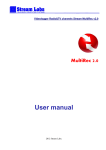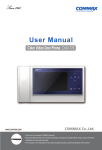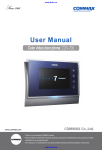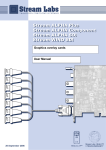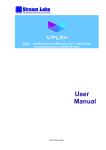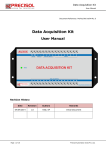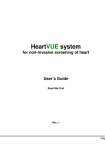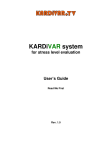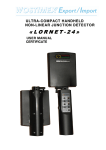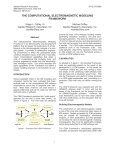Download Series Manual. Version September, 2010 - TS
Transcript
HANDHELD FREQUENCY AND POWER METER MFP-8000 USER MANUAL CERTIFICATE © TS-Market Contents 1. General..................................................3 2. Warning.................................................5 3. Delivery Set...........................................6 4. Specifications.......................................7 5. Instrument Controls.............................8 6. Operating Guide...................................9 6.1. «Panorama» Mode......................10 6.2. «Search» Mode........................... 11 6.3. «Fix Level» Mode........................12 6.4. «Pulse» Mode..............................13 6.5. Work with the Settings Menu.......14 7. Charging the battery..........................17 8. Measurement Background................19 8.1. Frequency Measurement.............19 8.2. Electromagnetic Field Indicator...20 8.3. Operating Failures.......................22 9. Manufacturer`s Warranty...................22 10. Importer:............................................23 10. Claims Data.......................................23 1. General The present User Manual is for a handheld frequency and power meter MFP-8000 describing its prin-ciples of operation. MFP-8000 can be used to measure frequency and power of radio signals in a wide range of develop-ment, diagnostic, adjustment and search applications related to radio devices. Specialists are familiar with manual field indicators of MFP series used for these purposes with an option of measuring frequency. These handheld devices have worked reliably during many years, the latest from them is MFP-3. The handheld frequency and power meter MFP-8000, developed on the basis of the latest advances in the RF components and technology and vast engineering and operating experience incorporates the best properties and features of MFP instruments. MFP-8000 can detect any sources of radio emission within the frequency range from 100 kHz up to 8GHz featuring sensitivity of -53dBm with a typical S/N ration of 5dB. That means that a transmitting device with an output power of +7dBm (5mW) coupled to a matched 1/4 wavelength antenna can be easily detected from the distance of up to 8m. MFP-8000 provides the user with a wealth of functions: • It can determine frequency of the input signal within a frequency range from 100 kHz to 8 GHz. • It can measure power of the input signal within a level range from -50dBm to +30dBm. • It can identify in the input signal characteristic features of the data transfer protocol for different communication standards (GSM 900/1800/1900, DECT), e.g. for GSM it can determine “SMS” and “Talk” operating modes, as well as the frequency channel. • It can automatically tune radio receivers and spectrum analyzers to the measured signal frequency via a built-in interface (option, ordered separately). • It can use its built-in memory, clock and calendar functions to protocol and store measurement re-sults. • It can be integrated into automated systems of radio monitoring via a serial interface. • It can utilize acoustic feedback mode during search work. • It supports surveillance mode when it responds to signals with a power level exceed ing a specified threshold. MFP-8000 has the following features: • 30dB input attenuator adjusted in 10dB steps. • Count time selection. • Input frequency range selection. • User level correction setting. • Battery charge/discharge control. • Real-time clock and calendar. • Built-in light and acoustic indication. • RS-232 interface. 2. Warning Attention! The manufacturer reserves the right to make small design changes not decreasing (but im-proving) its operating specifications. In this case the present User manual may not fully correspond to the modification of the device you have. To get comprehensive and the most upto-date information, please, download the latest versions of the User Manual at the manufacturer`s web-site www.elvira.ru. Before turning the device on study the present Manual thoroughly, and further strictly follow its requirements. It is strictly forbidden to disassemble the device independently and to connect to it devices not covered in the present Manual. Warranty and after-warranty service of the device is provided by the manufacturer only if the present manual is submitted and the Certificate is properly filled in, and there is no damage of sealing. If there are mechanical damages in the device, if the device has been operated in a chemically aggressive environment, if water, dirt and insects are found inside the device, or if a user violates the operating instructions, sealing and requirements of this Manual the warranty liabilities become ineffective. 3. Delivery Set № 1 2 3 4 5 6 7 8 9 Name, type MFP-8000 Antenna А-1 Antenna А-2 N-BNC adapter RS-232 interface cable Charger User Manual Certificate Package box Number, pcs. 1 1 1 1 1 1 1 1 1 4. Specifications • • • • Frequency range: 100 kHz…8 GHz. Maximum safe input level: +30dBm (1W). Input impedance: 50 Ohm. Dynamic range of power level measurement: 90dB, (-60dBm…+ 30dBm). • Accuracy of power level measurement: ± 0.5dB. • Sensitivity for frequency measurement: ≤-45dBm (-45dBm 1.26mV) for the frequency range (300¸6000) MHz, ≤12,68mV (-25dBm) for the ranges (0.1¸ 0.3) MHz and (6000¸8000) MHz. • Typical sensitivity of power measurement: ≤ -53dBm (S/N >5dB). •13MHz reference oscillator: ± 2.5ppm (-30 +80 °C), ±1,5ppm (+25 °C). • VSWR ≤1,5. • Operating temperature range: from 0°C up to +50 °C. • Power supply: a built-in Li-Ion battery 3.6 W/1.95 А/h. • Average current consumption: ≤ 250 mA. • Input connector: N-type (female). • Dimensions: 115mm х 70mm х 27mm. 5. Instrument Controls 1 6 2 7 3 8 4 9 5 10 Fig. 1 1) «CHK» (check) red LED – displays warning at extraordinary situation. 2) *Button to turn ON/OFF lighting and acoustic feedback mode. 3) «LOCK» (lockup) green LED – lights after a signal has been found. 4) Function button – a function is assigned in the assignment line (see. Fig. 2). 5) Button unit to move cursor (up, down, right, left). 6) Input connector *. 7) Display. 8) ON/OFF button and function button - a function is assigned in the assignment line (see. Fig. 2). 9) RS-232 interface connector*. 10) Battery charge socket. Notes: Control elements, marked with (*), are placed on the lateral side of the case. 6. Operating Guide The device is turned on/off by pressing and keeping ON/OFF button for about 3 seconds (see 8 in Fig. 1). After turning-on the main menu will appear on the display (see. Fig. 2), where the operating mode can be selected. Attention! If the display does not light up when the device is turned on (see 1 in Fig. 1) and «CHK» red LED is lighting instead, the battery must be charged for further operation. Choose the operation mode required moving the cursor up and down buttons (see 5 in Fig. 1) (marked with reverse brackets). A mode is activated after pressing button 4 (see Fig. 1) marked at the display in the function assignment line. Function assignment line Fig. 2 6.1. «Panorama» Mode Attenuator Frequency counter line Power meter line Function assigned to the button Time count Battery state Frequency range indicator Current time Fig. 3 Panorama mode can be used in all cases of measuring frequency and power of an electric signal applied to the instrument’s input connector. 10 In this mode frequency and level values acquired during each mea-suring cycle are continuously displayed at the indicator (see Fig. 3). Digital filtering techniques are not used. Fig. 4 Frequency of signal captured 6.2. «Search» Mode Search mode is used in the cases when sources of RF emission are to be found. In this mode digital fil-tering of the measured frequency is applied to facilitate signal identification and acoustic feedback mode can be switched on. An acoustic generator is switched on for a time while the «AUD» button is kept pressed (2 in Fig. 1). Signal frequency capture is signalized by lighting of the «Lock» green LED (3 in Fig. 1). The measured value can be read at the indicator (see Fig.4). This value will be displayed till switching over to another mode or turning off the device (even in the cases when signal sources are switched off). If no signal is found the appropriate message is displayed at the indicator (see Fig. 5). 11 Signal is not found Fig. 5 6.3. «Fix Level» Mode Threshold mark at the level scale Fig. 6 Excess threshold relative to the background level This mode is used for radio monitoring purposes. When this mode is first switched on, the level of elec-tromagnetic background is measured and its value is stored to the internal memory. Then the measured level is continuously updated and compared with the stored value. If the current level value exceeds the memorized one by the set threshold, the device outputs an appropriate alarm signal. 12 Pressing “right” button of the cursor unit 5 (see Fig. 1) one of five increment values (of excess thre-sholds) can be set: +3dB, +6dB, +12dB, +18dB or +24dB. When a stable signal exceeding the set thre-shold appears, the instrument captures it in realtime, «Lock» green LED lights up and the captured fre-quency value is displayed at the indicator. If «Message» function is active (see cl. 6.5.) the device out-puts an acoustic alarm signal. In this mode the attenuator is set to «Auto» position and indication level - to «Line» position by default. 6.4. «Pulse» Mode «Pulse» mode is used to identify the data transfer protocol for communication systems operating in GSM 900/1800/1900 and DECT standards. Besides, in the GSM standard the device determines the type of the transferred data: “SMS” (text) or “Talk” (speech) as well as the frequency channel. The view of this mode start screen is given in Fig.7. When a signal is found and analyzed (captured), the identified standard name will be indicated at the display (see Fig. 8) and «Lock» green LED will light up. 13 Fig. 7 Line of function buttons lighting: <SetAtt> – attenuator setting, <Clr> – data clearance. An SMS in the GSM900 standard is being transferred Fig. 8 Mobile station operating frequency 6.5. Work with the Settings Menu The settings menu can be entered in all modes except «Pulse» mode by pressing «SET» button. View of the settings menu window is given in Fig. 9. All movements in this menu and its sub-menus are made using cursor buttons (unit 5 - see Fig. 1) ac-cording to arrows: up, down, right, left. The position active at the moment is marked with 14 reverse brack-ets. Actions are accomplished by function buttons (view the function buttons assignment line). Attenuator setting Time count setting Setting of time and date Sound setting Frequency Function button range setting assignment line Level settings Fig. 9 The exact mode parameters are set in the opening sub-menus: «Attenuator», «Time count», «Frequency range», «Acoustic settings», «Time, date» and «Level settings» (see Fig. 10). Press <Set> function button to set time and date, a flickering marker will appear at the display. Use the cursor buttons unit to move marker between its positions (see Fig. 1) right and left, use up and down buttons to change the input value. To keep input settings press <Set> function button again. 15 Attenuator Time count Value set Frequency range Time, date Acoustic settings Level settings Fig. 10 16 7. Charging the battery The charge indicator placed in the right top corner of the display shows the charge level of the builtin battery (see Fig. 11). The battery charge level is approximately proportional to number of black sectors. To charge the battery when the device is on, connect a charger included with the instrument to the «CHG» socket (10 in Fig. 1), then to the mains. While the battery is being charged, the number of black sectors will increase. When charging is over all sectors are black, the device goes on operating. The bat-tery charging time in this case is about seven hours. Indicator of battery charge/discharge Fig. 11 If the device is off when a charger is connected to it, it will automatically switch over to the «QUICK CHARGE» mode (a corresponding inscription appears on the display). Charging time of a discharged battery is about 3 hours in this mode. When the battery charging is over, the device turns off automati-cally. 17 Attention! If the battery is discharged greatly, then a display does not switch on immediately. First «CHK» red LED lights, then the device switches over to «QUICK CHARGE» mode after some time (after the battery voltage achieves a certain value), and charging process goes on as described above. Please note that the lifetime of a built-in battery is limited: in 2 years from the date of the device manufacture it stops to provide its nominal capacity, and in 5 years it is subject to obligatory replacement re-gardless of its working state. The battery capacity value can be implicitly estimated by the charging time of a fully discharged battery. Decrease of charging time of a fully discharged battery by two times compared to the initial condition is a signal for a battery replacement. Replacement of the battery is made by the manufacturer (ELVIRA Production Company Ltd.). 18 8. Measurement Background 8.1. Frequency Measurement Function MFP-8000 implements a direct counting method for frequency measurements in all modes. It is possible to change the count time to obtain the required accuracy level for determining the input signal frequen-cy. Count time can be set within a range from 1ms up to 1000 ms. The relative uncertainty of a frequen-cy value averaged over the count time does not exceed the value determined by the following formula: where: - frequency stability of the reference oscillator; - measured frequency value, kHz; - count time, ms; - input prescaler division ratio. 19 Division ratio of the input prescaler is equal to: N =1 for the frequency range (0.1÷200) MHz; N =4 for the frequency range (200÷600) MHz; N =8 for the frequency range (600÷1200) MHz; N=16 for the frequency range (1200÷2500) MHz; N=32 for the frequency range (2.5÷4,8) GHz; N=64 for frequency range (4.8÷8) GHz. MFP-8000 utilizes a ± 1.5ppm TCXO to achieve highly accurate frequency measurements. 8.2. Electromagnetic Field Indicator Function MFР-8000 with an antenna can also be used as a high-sensitive indicator of electromagnetic field. It will identify radio emission sources with a signal power at the device input exceeding -53dBm within a frequency range from 100 kHz up to 8 GHz. For that purpose MFР – 8000 has a corresponding 20 selec-tion of different modes (see cl. 6.1…6.5). In a free environment the device will reliably detect any RF sources with an output power of +7dBm from the distance of up to 20 meters. MFP-8000 has a dedicated detector, amplifier and an acoustic generator to implement the acoustic feed-back mode for radio microphones identification and location. The acoustic generator is switched on for the time while the «AUD» button is kept pressed (2 in Fig. 1). MFР–8000 also has a dedicated «close field» monitoring mode (see cl. 6.3.). In this mode the device gives an alarm signal if a radio source with a level exceeding a specified threshold value has been identi-fied. The operator can set the threshold value within a range from +3 up to +24dB relative to the back-ground level. Besides, MFP-8000 can store to its internal memory an entire measurements protocol with up to 1000 values for future analysis. MFР - 8000 can automatically tune scanning receivers (e.g. AOR 8000 type) or spectrum analyzers to the measured frequency via a built-in interface. Moreover, the RS-232 interface enables MFР - 8000 control from an external PC as well as data transfer to an external PC for processing. 21 8.3. Operating Failures Electrostatic discharge, high power electromagnetic pulses and other extraordinary effects may negatively impact on the device correct operation. Under certain conditions it may even “hang-up” and not respond to the control buttons. In this case try to use the «reset» button first. For that purpose carefully press the “reset” button with a thin object (e.g. with an unbent clip) through a hole placed on the back cover of the device near the acoustic generator grating. After that the device should reboot and return to the main menu. If it nevertheless does not, contact the manufacturer. 9. Manufacturer`s Warranty The manufacturer guarantees device operating capability provided that the customer follows operation, transportation and storage conditions stated in the present User Manual. Warranty period for the device is 18 months from the acceptance date. The acceptance date must be fixed in the present User Manual. If the device fails during warranty period provided that a customer follows operation, transportation and storage conditions stated in the present User Manual, the manufacturer will remove the defect free of charge and take measures to exclude such defects in future. 22 10. Importer: TS-Market Ltd. Building 10-1 Sosnovaya Alleya, Zelenograd, Moscow, the Russian Federation, 124489. Tel.: +7(495) 638-8800 Fax.: +7 (499) 940-9575 www.ts-market.com [email protected] 10. Claims Data In case of package damage during transportation claims are presented to the freight forwarder. If the delivery set is not complete or the handheld frequency and power meter MFP - 8000 is damaged, provided that a package is not damaged, an Act is made together with a representative of the manufac-turer. If a defect appears during the warranty period, a customer is to send the handheld frequency and power meter MFP - 8000 to the manufacturer with an accompanying letter, stating the reason of the claim. All claims put in, their brief description and measures taken are recorded in Table 1. 23 Claim content 24 Reason, measures taken Notes






























![Defining Event Handlers [Backbase Manual]](http://vs1.manualzilla.com/store/data/005692904_1-d6f01c41c66ce6049d8fb6a78592ae1b-150x150.png)

